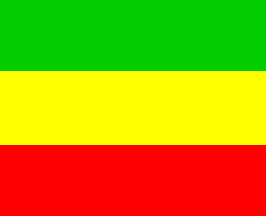
image by Ivan Sache, 9 June 2001

Last modified: 2009-08-08 by dov gutterman
Keywords: education |
Links: FOTW homepage |
search |
disclaimer and copyright |
write us |
mirrors
See Also:
Other Institutions:

image by Ivan Sache, 9 June 2001
Universidad de Narino - 22:27 flag, horizontally divided
green-yellow-red. Flag shown on <www.udenar.edu.co>,
located by Dov Gutterman, with proportion 2:3. Anyway,
the text near the image clearly states that the proportion shall
be 22:27, the usual size being 1.10 x 1.35 m and the flag being
hoisted on a pole of 2.50 m high. The shield of the University
shall be placed in its middle (I don't understand of what, the
pole, or, most probably, the flag itself).
Ivan Sache, 9 June 2001

image by Ivan Sache, 30 January 2009
"Institución Educativa 'Nazario Restrepo'" was
founded by Priest Luis Diez Mesa in the Municipality of Viterbo,
Department of Caldas, on 4 February 1955, as "Colegio
'Nazario Restrepo'". The institute is named after Nazario
Restrepo, the priest who founded the settlement of Viterbo on 19
April 1911 by celebrating there a mass.
The flag of the institute, as shown graphically and described on
the website
of the institute, is green with a white star in the middle.
The text says that the original idea for the flag has to be
credited to teacher Javier Patiño Hincapié, who designed a
green flag of unspecified dimensions, crossed by a red arrow and
the Latin motto "Sursun cum laetitia" (Quicker with
joy), and a white star above the arrow.
The upper left part of the emblem of the institute shows on a
green field a book surmonted by an arrow and a star, all white.
Green represents the hope placed by the community into the youth.
The white star represents the purity of the students' heart.
Note: The horizontally divided yellow-blue-yellow flag with a
white star in the middle, shown on the front page of the website
of the institute, is the municipal flag of Viterbo.
Ivan Sache, 30 January 2009
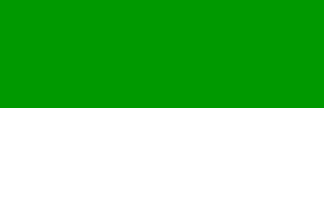
image by Ivan Sache, 18 January 2009
"Colegio 'Nicolás Esguerra'" was the first free
educational institute founded in Bogotá. In 1938, the Congress
issued Honour Law No. 35, whose Article 3 granted to the
institute the name of the the journalist, lawyer and diplomat
Nicolás Esguerra (1832-1923).
The flag of the instutute, as shown graphically on the website
of the institute, is horizontally divided green-white.
Ivan Sache, 18 January 2009

image by Ivan Sache, 10 January 2004
The College is located on Giron, Santander department. Its
flag is horizontally divided white-light blue (azul).
Source: <www.voluntad.com.co>,
located by Dov Gutterman.
Ivan Sache, 10 January 2004

image by Ivan Sache, 9 January 2009
"Colegio Adventisto del Norte" was founded in 1984
in Bogotá by the Seventh-day Adventist Church, as "Colegio
Integral de Enseñanza Cristiana", and took its today's name
in 1992.
The flag of the institute, as shown graphically and described on
the website
of the institute, is white with two light blue and red
rectangles placed along the hoist and the emblem of the institute
in the middle of the flag.
The blue rectangle represents the Adventist education, projected
to heavens.
The red rectangle represents the blood sacrified by Jesus for the
reconciliation of mankind and God.
The white square represents a transformed life, symbol
of divine justice and redemption.
The emblem of the institute is a symbol of faith representing the
Christian philosophy and education taught in the institute. The
shield is blue, bordered by a red pentagon outlined in
yellow, representing the five continents covered by the Adventist
teaching, charged with the black writing "COLEGIO ADVENTISTA
DEL NORTE Bogotá D.C." The emblem is charged with a white
triangle outlined in yellow and charged with the emblem of the
Adventist Church, made of a golden flame representing the Holy
Spirit, a white cross representing Jesus, and a green book
representing the Bible, the base and source of all knowledge. The
triangle is surrounded by the black writing "MANO"
("hand", left), "MENTE" ("spirit",
right) and "CORAZÓN" ("heart", bottom),
exalting the integrity of the Adventist teaching.
Ivan Sache, 9 January 2009

image by Ivan Sache, 31 January 2009
"Gimnasio del Norte" was founded on 31 October 2002
in Valledupar, Department of Cesar, by the educators Pedro Ángel
Daza Mendoza and Berenice Flórez de Daza.
The flag of the institute, as shown graphically on the website of the
institute, is vertically divided light blue-white.
Ivan Sache, 31 January 2009
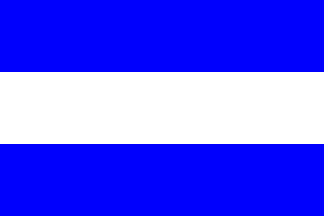
image by Ivan Sache, 7 February 2009
"Gimnasio Norte del Valle" was founded on 6 July
1977 in Roldanillo, Department of Valle del Cauca.
The flag of the institute, as shown graphically on the website of the
institute, is horizontally divided blue-white-blue.
Ivan Sache, 7 February 2009

image by Ivan Sache, 3 January 2009
"Colegio Parroquial Nuestra Señora de
Chiquinquirá" was founded in 1964 by Priest Ernesto
Villegas in Bello, a municipality part of Greater Medellín,
Department of Antioquia. The institute is named after the
patroness of Colombia, Our Lady of the Rosary (see: <www.churchforum.org
>).
The flag and coat of arms of the institute were created by Sister
Teresita Mora in 1973.
The flag, as shown graphically on the website
of the institute, is blue with a white stripe in the middle,
a "cristofer" (Cross of Lorraine) in its left part and
three stars in its right part, all white. Blue and white are the
Marian colours.
From the drawing, it can be guessed (but not ascertained) that
the white stripe follows the ascending diagonal. The location and
size of the charges are not straightforward: the stars,
representing science, virtue and life, seem to be four-pointed,
in increasing size from left to right; on the coat of arms,
however, they are of equal size, five- pointed and
placed along the ascending fiagonal. The "cristofer"
represents the Archbishopric (I guess, of Medellín).
On the website of the institute, the image of the coat of arms is
much less ambiguous than the image of the flag, which seems to
have been directly derived from the shield, and should,
therefore, have the same graphical characteristics.
Ivan Sache, 3 January 2009
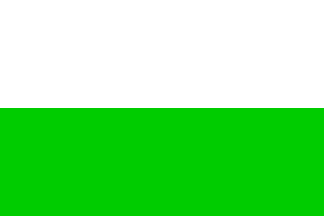
image by Ivan Sache, 4 February 2009
"Instituto Nuestra Señora del Amparo" (INSA) was
founded in Bogotá by the Congregation of "Dominicas Hijas
de Nuestra Señora de Nazareth" (Dominican Daighters of Our
Lady of Nazareth). The congregation, founded on 25
March 1938 by Mother Maria Sara Alvarado Ponton (1902-1980) and
Friar Enrique Alberto Higuera Barrera (1906-1976), was
canonically recognized by the Holy See on 8 September 1975.
The flag of the institute, as described on the webpage of
the institute, is horizontally divided white-green. White
represents the devotion to the Blessed Virgin, translated as an
invitation to live in purity and to build a pacific society.
Green represents the aspiration to a better world and the
significance of ecology for the students.
Ivan Sache, 4 February 2009
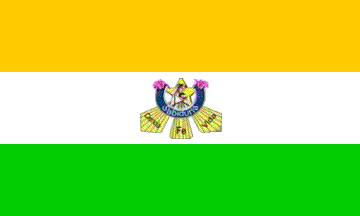
image by Ivan Sache, 1 February 2009
"Instituto Nuestra Señora de la Sabiduría para Niños
Sordos" (for deaf children) was founded by a French nun,
Mother Ives del Sagrado Corazón de Jesús, in San Juanito,
Department of Meta, on 17 March 1924. This was the first attempt
of specific education for deaf children in Colombia. President of
the Republic Eduardo Santos Teniendo Conocimiento ordered the
transfer of the institute to Bogotá, which was completed on 8
May 1940.
The institute is ran by sisters of the Congregation of the
Daughters of Wisdom, one of the three branches of the Montfortian
family. The three congregations originate in the Company of Mary,
founded by St. Louis-Marie Grignon de Montfort (1673-1716,
canonized in 1947), who has remained famous for his devotion to
the Blessed Virgin.
The flag of the institute, as video-presented and described on
the website of the
institute, is horizontally divided dark (lit.
"burned") yellow-white-green with the emblem of the
institute in the middle. The dimension of the real flag is 2.50 m
x 1.50 m.
Yellow represents the belonging to the universal church and the
spiritual and philosophical resources of the Montfortian
spirituality.
White symbolizes simplicity, peace, truth and the virtues that
transcend all the acts in the life and allow the actions of the
educational community.
Green represents thr commitment to conservation and preservation
of natural resurces as well as hope.
The emblem of the institute, presented in the same way, is made
of a yellow star charged with an icon of the Blessed Virgin,
surmonting a King blue scroll charged with "Sabiduria"
(Wisdom) in white letters and ending with two pink orchids, from
which emerge three rays of yellow light charged with
"Ciencia" (Science), "Fe" (Faith) and
"Vida" (Life), respectively, all in black letters.
Blue is the symbol of happy life, dynamism, youth and search of
happiness through daily meetings with Jesus' wisdom.
Ivan Sache, 1 February 2009

image by Ivan Sache, 3 February 2009
The Congregation "Hijas de Nuestra Señora de las
Misericordias" (Daughters of Our Lady of Mercy) was founded
on 11 October 1951 in Santa Rosa de Osos, Deaprtment of
Antioquia, by His Grace Miguel Ángel Builes Gómez, Bishop of
Santa Rosa de Osos. The congregation has today 30 houses in nine
countries.
The Congregation runs two educational institutes in Colombia,
"Collegio Técnico Nuestra Señora de las
Misericordias" in Santa Rosa de Osos and "Collegio
Nuestra Señora de las Misericordias" in Soacha, Department
of Cundinamarca.
The flag of the congregation, as shown graphically on the website of the
congregation, is horizontally divided white-light blue, the
traditional Marian colours.
Ivan Sache, 3 February 2009
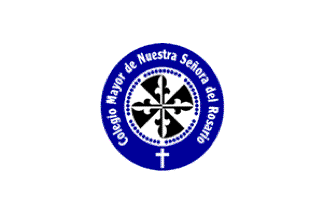
image by Ivan Sache, 6 January 2009
"Colegio Mayor de Nuestra Señora del Rosario" was
founded in 1654 in Arrayanes by the Dominican Friar Cristóbal de
Torres, with permission of King of Spain Philip IV. Torres
redacted the same year the "Constitutions" of the
institute, based on those set up for the famous institute of
Salamanca. Still forming the legal basis of the institute, the
Constitutions were amended only a few times, in 1893, 1930, 1974,
1984 and 1995.
The flag of the institute, according to a photo available on the website of
the institute, is white with the emblem of the institute in
the middle.
The emblem is made of the Cross of Calatrava, which is the emblem
of the Dominican Order, surroundered by a rosary made of five
groups of ten small blue grains each, inscribed in a wide blue
ring charged with the name of the institute in white letters and
a white Latin cross at the bottom of the ring. Designed by Father
Torres, the original emblem has been submitted to various changes
all over the history of the institute.
Ivan Sache, 6 January 2009
"Gimnasio Nueva Escocia", founded in
1982, is located in Bogotá. The name of the institute
was proposed by members of the board who had studied in Halifax,
the capital of Nova Scotia, Canada.
The flag of "Gimnasio Nueva Escocia" is described on
the institute
website as follows: "Its white background symbolizes the
purity of the heart of the children and teenagers. The red stripe
symbolizes love that should unite all of us and all members of
the Nueva Escocia family. The blue stripe symbolizes the wide
horizon offerred to the students."
There is, unfortunately, no image helping to decide how the
colours are arranged on the flag.
Ivan Sache, 15 December 2008